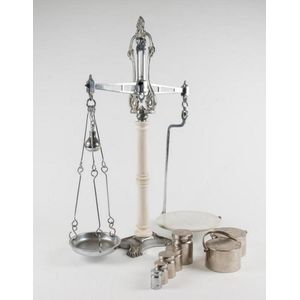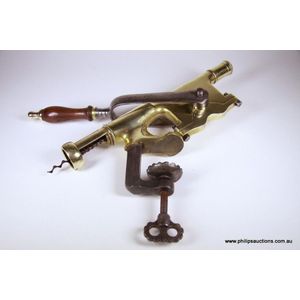George III Silver Dish Cross with Shell Feet & Conch Supports
You must be a subscriber, and be logged in to view price and dealer details.
Subscribe Now to view actual auction price for this item
When you subscribe, you have the option of setting the currency in which to display prices to $Au, $US, $NZ or Stg.
- Hallmarks - A mark stamped on articles of precious metals in Britain, since the 14th century, certifying their purity. It derives its name from the Guild Hall of the Goldsmiths' Company, who recieved its Charter in 1327 giving it the power to assay (test the purity) and mark articles of gold and silver.
The hallmark will consist of several marks, including the:
- silver standard mark, indicating the purity of the metal. Sterling silver is .925 pure silver.
- the city mark indicating the city in which it was assayed eg London, Birmingham, York etc.
- the date mark, usually a letter of the alphabet in a particular font and case,
- a duty mark, indicating whether duty had been paid to the crown, and only in use from 1784 to 1890
The piece may include an additional mark, the maker's mark, although not forming part of the hallmark, will be located in the vicinity of the hallmarks.
Sometimes silver plated items will bear faux hallmarks, often confusing those not familiar with silver markings. - George Iii - George III (1738 - 1820) was King of Great Britain and Ireland from 1760 to 1820.
- Sterling Silver - Sterling silver is a mixture of 92.5% pure silver and 7.5% of another metal, usually copper. Fine silver is 99.9% pure silver, and is relatively soft and the addition of the very small amount of copper gives the metal enough strength and hardness to be worked into jewellery, decorative and household objects.
- Circa - A Latin term meaning 'about', often used in the antique trade to give an approximate date for the piece, usually considered to be five years on either side of the circa year. Thus, circa 1900 means the piece was made about 1900, probably between 1895 and 1905. The expression is sometimes abbreviated to c.1900.
This item has been included into following indexes:
Visually similar items

Grocers scales by Hunt & Co. London, white porcelain column & nickel plated body & weights (set of 7 denominated in dollars from $5 dollars through to $100), circa 1850s. 82 cm. Provenance: Private collection Bendigo.

Edward VII sterling silver Brandy warmer plain baluster form, ivory handle on wire form stand

A good antique brass mounted corkscrew, late 19th century, with maker's mark for W.G Edmonds, Dublin, the heavy gauge brass, steel and timber handled cork screw, for bench mounting and with lever action; stamped maker's mark to the brass body. Width 41 cm

A pair of solitaire diamond stud earrings; each set in 9ct gold with a round brilliant cut diamond. Estimated diamond weight 2 = 0.52ct, VS and Si. Wt. 1g.
